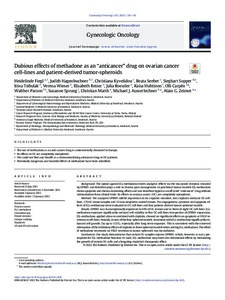Dubious effects of methadone as an “anticancer” drug on ovarian cancer cell-lines and patient-derived tumor-spheroids
Fiegl Heidelinde; Hagenbuchner Judith; Kyvelidou Christiana; Seeber Beata; Sopper Sieghart; Tsibulak Irina; Wieser Verena; Reiser Elisabeth; Roessler Julia; Huhtinen Kaisa; Carpén Olli; Parson Walther; Sprung Susanne; Marth Christian; Ausserlechner Michael J.; Zeimet Alain G.
https://urn.fi/URN:NBN:fi-fe2022081154784
Tiivistelmä
Background
The opioid agonist D,L-methadone exerts analgesic effects via the mu opioid receptor, encoded by OPRM1 and therefore plays a role in chronic pain management. In preclinical tumor-models D,L-methadone shows apoptotic and chemo-sensitizing effects and was therefore hyped as an off-label “anticancer” drug without substantiation from clinical trials. Its effects in ovarian cancer (OC) are completely unexplored.
Methods
We analyzed OPRM1-mRNA expression in six cisplatin-sensitive, two cisplatin-resistant OC cell-lines, 170 OC tissue samples and 12 non-neoplastic control tissues. Pro-angiogenetic, cytotoxic and apoptotic effects of D,L-methadone were evaluated in OC cell-lines and four patient-derived tumor-spheroid models.
Results
OPRM1 was transcriptionally expressed in 69% of OC-tissues and in three of eight OC cell-lines. D,L-methadone exposure significantly reduced cell-viability in five OC cell-lines irrespective of OPRM1 expression. D,L-methadone, applied alone or combined with cisplatin, showed no significant effects on apoptosis or VEGF secretion in cell-lines. Notably, in two of the four spheroid models, treatment with D,L-methadone significantly enhanced cell growth (by up to 121%), especially after long-term exposure. This is consistent with the observed attenuation of the inhibitory effects of cisplatin in three spheroid models when adding D,L-methadone. The effect of methadone treatment on VEGF secretion in tumor-spheroids was inconclusive.
Conclusions
Our study demonstrates that certain OC samples express OPRM1, which, however, is not a prerequisite for D,L-methadone function. As such, D,L-methadone may exert also detrimental effects by stimulating the growth of certain OC-cells and abrogating cisplatin's therapeutic effect.
Kokoelmat
- Rinnakkaistallenteet [27094]
